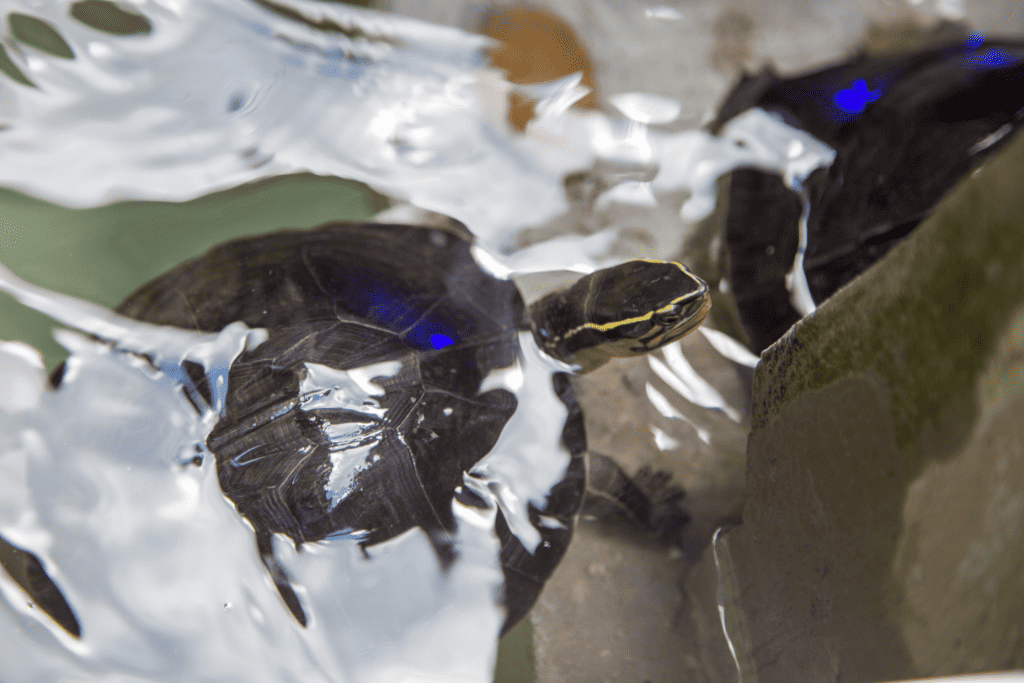Box turtles are a popular pet due to their small size and docile nature. However, one question that often comes up when it comes to caring for box turtles is whether or not they can swim. In this article, we will explore the swimming abilities of box turtles and what you should know if you are thinking of getting one as a pet.
Box Turtle Anatomy
Box turtles have a unique anatomy that sets them apart from other types of turtles. Their shells have a hinge on the bottom, allowing them to close up tightly and protect themselves from predators. This same hinge also makes it difficult for them to swim, as it limits their mobility in the water.
Box Turtles in the Wild
In the wild, box turtles will often find a pond or stream to soak in, but they are not true swimmers. They will typically use their legs to paddle along the bottom or cling to aquatic plants to keep themselves afloat. They are not able to swim long distances and will quickly tire if they try to swim for extended periods.
Box Turtles as Pets
If you are considering getting a box turtle as a pet, it is important to keep in mind that they will not be able to swim in a traditional sense. They will need a shallow water area in their enclosure that they can soak in, but it should not be deep enough for them to submerge completely. A water dish or small plastic kiddie pool is sufficient.

Can a Box Turtle Drown?
While box turtles are not able to swim, they are able to hold their breath for a short period of time. They can survive underwater for a few minutes but it’s not recommended to keep them submerged for long periods of time. If a box turtle is submerged for too long, it will eventually drown. It is important to make sure that the water in the turtle’s enclosure is not too deep, and that there are places for the turtle to rest on the surface of the water. Additionally, it’s important to keep the water clean and free of bacteria to prevent the turtle from getting sick.
To avoid the risk of drowning, it’s important to always supervise your box turtle while it’s in the water. This will ensure that the turtle doesn’t accidentally get stuck in a deep area, or that it’s not struggling to get back to the surface. Furthermore, you should make sure that the turtle’s enclosure has a dry area where the turtle can rest and get out of the water.
In summary, box turtles can survive underwater for a short period of time, but they are not able to swim and can drown if submerged for too long. Proper care and supervision is essential to ensure the safety of your pet box turtle.
Box Turtle Behavior and Habits in Water
Box turtles in the wild will often spend time in and around water sources, but they are not strong swimmers. They will use their legs to paddle along the bottom or cling to aquatic plants to keep themselves afloat. As pets, box turtles should have access to a shallow water area in their enclosure, such as a water dish or small plastic kiddie pool, where they can soak and cool off. It’s important to provide a ramp or a shallow area for them to easily get in and out of the water.
Box Turtle Health and Water
Proper water care is essential for the health of your box turtle. If the water in the enclosure is dirty or not properly maintained, it can lead to health issues such as shell rot or respiratory infections. It’s important to keep the water clean by doing regular water changes and adding a water conditioner to remove chlorine and other harmful chemicals. Additionally, it’s important to provide a basking area where the turtle can dry off and get out of the water to prevent shell rot.
Box Turtle Enrichment and Water
Water can be used as an enrichment tool for box turtles. Providing floating plants or creating a current in the water can provide mental and physical stimulation for your pet turtle. Additionally, adding small toys or treats to the water can encourage natural foraging behavior. It’s important to note, however, that any items added to the water should be safe for the turtle to interact with and should not pose a choking hazard.

Box Turtle Water and Diet
Water plays an important role in the diet of box turtles. In the wild, they will often graze on aquatic plants and insects found in and around water sources. As pets, providing a variety of aquatic plants for them to munch on can help to mimic this natural diet. Additionally, it’s important to ensure that the turtle is properly hydrated, as this can aid in digestion and overall health.
Box Turtle Water and Training
Water can also be used as a training tool for box turtles. Teaching your turtle to come out of the water on command can be a useful skill, especially if you need to move or handle them. Additionally, rewarding your turtle with a soak in the water can be a great motivator during training. It’s important to note, however, that regular and consistent training is essential for success.
In conclusion, box turtles are not strong swimmers and should not be kept in deep water. They will need a shallow water area in their enclosure where they can soak, but it should not be deep enough for them to submerge completely. Proper care and supervision is essential to ensure the safety of your pet box turtle and to provide them with a healthy and stimulating environment.
Conclusion
In conclusion, box turtles are not able to swim in the traditional sense. They have a unique anatomy that limits their mobility in the water, and they are not able to swim long distances. If you are considering getting a box turtle as a pet, be sure to provide them with a shallow water area for soaking, but not deep enough for them to submerge completely.






